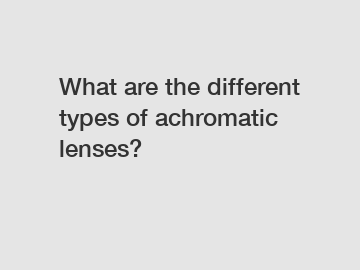Mar. 27, 2024
Link to CLZ
If you are in the field of optics or photography, you may have come across the term "achromatic lenses" before. These lenses are essential components in many optical systems, as they are designed to reduce chromatic aberration and improve image quality. But what exactly are achromatic lenses, and what different types are available?
Achromatic lenses are a type of lens that is designed to bring two different wavelengths of light into focus at the same point. This is important because different wavelengths of light (colors) bend at different angles when passing through a lens, leading to what is known as chromatic aberration. Chromatic aberration can result in blurry images and reduce the overall quality of an optical system.

There are several different types of achromatic lenses available, each with its own unique properties and applications. Here are some of the most common types:
1. Doublet Achromatic Lens:
The most common type of achromatic lens is the doublet achromatic lens. This lens consists of two separate lenses made from different types of glass, with different dispersion properties. By combining these two lenses, the doublet achromatic lens is able to correct for chromatic aberration and bring two different wavelengths of light into focus at the same point.
Doublet achromatic lenses are widely used in photography and microscopy, where high image quality is essential. They are also relatively affordable and easy to manufacture, making them a popular choice for many optical applications.
2. Triplet Achromatic Lens:
Triplet achromatic lenses are similar to doublet achromatic lenses, but they consist of three separate lenses instead of two. This additional lens allows triplet achromatic lenses to correct for even more aberrations, such as spherical aberration and coma. Triplet achromatic lenses are often used in high-end optical systems where maximum image quality is required.
While triplet achromatic lenses offer superior image quality compared to doublet achromatic lenses, they are also more expensive and difficult to manufacture. This makes them less common in everyday optical applications but essential in specialized fields where precision and clarity are paramount.
3. Cemented Achromatic Lens:
Cemented achromatic lenses are a type of achromatic lens where the two lens elements are "cemented" together using a special optical adhesive. This design helps to reduce internal reflections and improve image contrast. Cemented achromatic lenses are commonly used in imaging systems where high resolution and contrast are key, such as in telescopes and cameras.
Cemented achromatic lenses are also more stable and durable than other types of achromatic lenses, as the adhesive helps to hold the two lens elements in place. However, they can be more susceptible to thermal expansion and contraction, which may affect their performance in extreme temperature conditions.
4. Air-Spaced Achromatic Lens:
Air-spaced achromatic lenses are similar to cemented achromatic lenses, but with a small air gap between the two lens elements. This design helps to reduce the risk of internal reflections and increase light transmission, resulting in improved image quality. Air-spaced achromatic lenses are frequently used in high-performance optical systems where maximum clarity and resolution are required.
While air-spaced achromatic lenses offer superior image quality compared to cemented achromatic lenses, they are also more sensitive to environmental conditions such as temperature and humidity. Careful handling and storage are required to maintain their performance over time.
In conclusion, achromatic lenses are essential components in many optical systems, as they help to reduce chromatic aberration and improve image quality. There are several different types of achromatic lenses available, each with its own unique properties and applications. Whether you are a photographer, scientist, or hobbyist, understanding the different types of achromatic lenses can help you choose the right lens for your specific needs and achieve the best results in your optical projects.
If you want to learn more, please visit our website.
For more plano-concave lensesinformation, please contact us. We will provide professional answers.
Previous: What are stock lenses in glasses?
Next: None
If you are interested in sending in a Guest Blogger Submission,welcome to write for us!
All Comments ( 0 )